Difference between revisions of "Wound Types - Donkey"
| (8 intermediate revisions by the same user not shown) | |||
| Line 1: | Line 1: | ||
| + | {{review}} | ||
Although wounds are given specific classifications, most have properties of | Although wounds are given specific classifications, most have properties of | ||
| Line 5: | Line 6: | ||
from those afflicted in the course of elective or other surgical procedures. | from those afflicted in the course of elective or other surgical procedures. | ||
| − | |||
'''[[Graze/abrasion/erosion - Donkey|Graze/abrasion/erosion]] | '''[[Graze/abrasion/erosion - Donkey|Graze/abrasion/erosion]] | ||
| + | |||
| + | |||
'''[[Bruise - Donkey|Bruise]] | '''[[Bruise - Donkey|Bruise]] | ||
| Line 13: | Line 15: | ||
'''[[Contusion - Donkey|Contusion]] | '''[[Contusion - Donkey|Contusion]] | ||
| + | |||
'''[[Puncture Wound - Donkey|Puncture wound]] | '''[[Puncture Wound - Donkey|Puncture wound]] | ||
| + | {{review}} | ||
| + | [[Image:Puncture wound.jpg|left|thumb|250px|<small><center>A fresh puncture wound in a donkey - the wound is likely to heal rapidly but the risks of tetanus are more significant. Is the donkey vaccinated and, if not, can suitable protection be provided with antiserum and penicillin? (Image courtesy of [http://drupal.thedonkeysanctuary.org.uk The Donkey Sanctuary])</center></small>]] | ||
| + | [[Image:Puncture wound 2.jpg|right|thumb|250px|<small><center>Close up of the puncture wound (Image courtesy of [http://drupal.thedonkeysanctuary.org.uk The Donkey Sanctuary])</center></small>]] | ||
| + | '''Definition: a puncture wound is a wound that has depth rather than size.''' | ||
| + | |||
| + | Puncture wounds in the skin and hoof etc., from sharp objects (e.g. nails, | ||
| + | glass shards, bullets or other foreign bodies) are common and potentially | ||
| + | very serious, although they are easily overlooked or trivialized. The size of | ||
| + | the wound often belies the potential severity of the injury. The skin defect is | ||
| + | usually trivial by comparison to the deeper damage. Even apparently minor | ||
| + | wounds can be fatal if they involve synovial structures, the cranium or the | ||
| + | body cavities. There is a high risk also from infection and anaerobes are | ||
| + | particularly dangerous. The wounds may be difficult to explore effectively; this applies particularly to the sole of the foot. Infections of the interstitial tissues and the lymphatic vessels are termed cellulitis and lymphangitis | ||
| + | respectively. In either case, infection can spread extensively from the site | ||
| + | of the injury. This type of wound proves the ideal anaerobic environment | ||
| + | for [[Clostridium species|Clostridial organisms]] to flourish. [[Clostridium species#Clostridium tetani|''Clostridium tetani'']] is possibly the most dangerous of these. | ||
| + | |||
| + | Management of puncture wounds requires a detailed knowledge of the | ||
| + | regional anatomy and some information on the cause and the direction of | ||
| + | the penetration. Puncture wounds must be treated by scrupulous cleaning | ||
| + | and, if necessary, widening of the injury to ensure full cleaning and avoidance | ||
| + | of anaerobic conditions. [[Antibiotics]] and [[NSAIDs|non-steroidal anti-inflammatory | ||
| + | drugs]] are usually used. Controlled movement is usually considered to be an | ||
| + | important aid to treatment. Tetanus prophylaxis is a major issue. | ||
| + | |||
| + | Healing of the skin wound is incidental in all cases. | ||
| + | ==References== | ||
| + | |||
| + | * Knottenbelt, D. (2008) The principles and practice of wound mamagement In Svendsen, E.D., Duncan, J. and Hadrill, D. (2008) ''The Professional Handbook of the Donkey'', 4th edition, Whittet Books, Chapter 9 | ||
| + | {{toplink | ||
| + | |backcolour = D1EEEE | ||
| + | |linkpage =Wound Types - Donkey | ||
| + | |linktext =Wound Types - Donkey | ||
| + | |rspace={{Donkey}} | ||
| + | |pagetype=Donkey | ||
| + | }} | ||
'''[[Incised Wound - Donkey|Incised wound]] | '''[[Incised Wound - Donkey|Incised wound]] | ||
| + | {{review}} | ||
| + | '''Definition: an incised wound is one in which the skin is cut cleanly with minimal tearing and bruising of the wound margins.''' | ||
| + | |||
| + | An incised wound (including a surgical wound) has a sharply defined | ||
| + | margin and is caused by sharp metal or glass, flint or occasionally the leading | ||
| + | edge of a shoe. In accidental wounds concurrent injury to non-cutaneous | ||
| + | structures is common. | ||
| + | |||
| + | The reflex arterial constriction that occurs when skin is cut means that | ||
| + | there is usually remarkably little haemorrhage in the immediate post-injury | ||
| + | stage. Thereafter, there may be considerable haemorrhage associated with | ||
| + | vasodilation, especially if arteries/arterioles are involved. '''Haemorrhage''' | ||
| + | may be controlled by '''pressure bandaging or clamping/ligation''' of significant | ||
| + | vessels. | ||
| + | |||
| + | Incised wounds are often amenable to first intention healing and, with the | ||
| + | possible exception of the distal limb where there is some controversy over | ||
| + | the need to or benefit from suturing, healing is correspondingly rapid. | ||
| + | |||
| + | '''Important note''' | ||
| + | '''As nerves and arteries often run in close proximity, blindly feeling for the vessel with a pair of haemostats in the conscious donkey can be very dangerous!''' | ||
| + | ==References== | ||
| + | |||
| + | * Knottenbelt, D. (2008) The principles and practice of wound mamagement In Svendsen, E.D., Duncan, J. and Hadrill, D. (2008) ''The Professional Handbook of the Donkey'', 4th edition, Whittet Books, Chapter 9 | ||
| + | |||
| + | {{toplink | ||
| + | |backcolour = D1EEEE | ||
| + | |linkpage =Wound Types - Donkey | ||
| + | |linktext =Wound Types - Donkey | ||
| + | |rspace={{Donkey}} | ||
| + | |pagetype=Donkey | ||
| + | }} | ||
'''[[Laceration - Donkey|Laceration]] | '''[[Laceration - Donkey|Laceration]] | ||
| + | {{review}} | ||
| + | [[Image:Eyelid laceration.jpg|right|thumb|250px|<small><center>Lacerations are common at almost every site on the body! Here an eyelid laceration in a middle-aged donkey before and after cleaning is shown. The injury was two days old when it was first seen. (Image courtesy of [http://drupal.thedonkeysanctuary.org.uk The Donkey Sanctuary])</center></small>]] | ||
| + | [[Image:Eyelid laceration 2.jpg|right|thumb|250px|<small><center>Injuries involving the eyelids have particular significance for the future function of the eye and so early attention is essential. (Image courtesy of [http://drupal.thedonkeysanctuary.org.uk The Donkey Sanctuary])</center></small>]] | ||
| + | |||
| + | '''Definition: a laceration is a traumatic tearing of the skin in an uncontrolled fashion.''' | ||
| + | Lacerations are the commonest skin injuries in donkeys. Multiple tears | ||
| + | in the skin may be accompanied by bruising but haemorrhage is rarely a | ||
| + | problem. | ||
| + | |||
| + | Management of lacerations usually involves careful wound preparation | ||
| + | and restoration of anatomical integrity by means of sutures or staples. | ||
| + | [[Antibiotics|Antibiotic therapy]] is usually applied for a period of four to six days. | ||
| + | The absence of ‘spare’ (loose) skin on limbs means that large deficits | ||
| + | in these sites require particular care. There is seldom any spare skin that | ||
| + | can be mobilized and so a prolonged recovery and/or expensive surgical | ||
| + | procedures may be expected. | ||
| + | |||
| + | '''Degloving injuries''' are commonest on the upper limb regions. The skin | ||
| + | on the lower limb is probably more firmly attached and seldom ‘degloves’ | ||
| + | in the same way as the upper limb and body trunk. These injuries should | ||
| + | be promptly treated to restore as much of the skin as possible to its | ||
| + | original position (even if it is probably non-viable). Degloving of limbs | ||
| + | usually involves at least some horizontal skin laceration and is usually in a | ||
| + | downward direction so that the skin hangs around the limb. The exposed | ||
| + | subcutaneous tissues rapidly become dry and infected but remarkably little | ||
| + | bleeding occurs in most such cases. The blood supply to the upper margin | ||
| + | of the wound is usually intact and so this is less of a problem than the | ||
| + | distal wound margin, which is invariably compromised, especially at the | ||
| + | most central part of the wound margin. Sloughing of the skin along this | ||
| + | margin is common. | ||
| + | |||
| + | The wound should be irrigated with '''copious warm sterile saline''' and | ||
| + | protected from further contamination by application of a '''hydrogel''' to the | ||
| + | exposed tissues. This will minimize dehydration and infection. '''Restoration | ||
| + | of the flap to its normal position''' as far as possible maintains warmth, | ||
| + | prevents further contamination and devitalisation and covers the exposed | ||
| + | tissues with a biological dressing. If feasible, a bandage should be applied | ||
| + | to limit further damage until a detailed examination can be performed. | ||
| + | Movement of the limb should be minimized so that tension on the wound | ||
| + | is reduced as far as possible. Shear forces will be maximal during movement | ||
| + | of the underlying muscles relative to the skin. | ||
| + | |||
| + | The wound should be carefully examined (possibly even under general | ||
| + | anaesthesia) and, after superficial irrigation, all obvious foreign matter | ||
| + | and devitalised subcutaneous tissues are scrupulously removed. Deeper | ||
| + | injuries are treated by lavage and, if indicated, by suturing the defects with | ||
| + | an absorbable suture material of suitable diameter and pattern. Skin should | ||
| + | not be removed unless it is totally devitalised and shredded; this applies | ||
| + | particularly to the eyelids. | ||
| + | |||
| + | Once the deep tissues have been repaired (possibly with drain placement), | ||
| + | the skin is restored to its normal position. Excessive tension on the wound | ||
| + | site will almost always result in wound dehiscence and further complications. | ||
| + | Carefully placed and securely knotted sub-cutaneous ‘walking’ sutures of a | ||
| + | fine absorbable material may allow the wound to be closed without undue | ||
| + | tension and will provide support for the flap of skin. However, if the injury | ||
| + | is more than one or two hours old, the skin will have shrunk significantly and it may be difficult to | ||
| + | restore it to its natural position. Undermining the adjacent attached skin and making small | ||
| + | 1 cm long overlapping relieving incisions (running parallel to the wound margins) may permit the | ||
| + | skin to be restored fully to the normal site without any undue tension on the wound margin. | ||
| + | Alternatively, it is sometimes wise not to attempt to restore the skin fully to its position and simply | ||
| + | suture the skin to the underlying tissues, as near as possible to the wound margin without excessive | ||
| + | tension. The uncovered area will then heal by [[Donkey - Fundamentals of healing#Secondary or second intention healing|second intention]] but will of course be much smaller than the original wound and may be amenable to skin grafting in | ||
| + | due course. | ||
| + | |||
| + | The skin wound is closed using '''interrupted horizontal or vertical mattress sutures''' with '''monofilament nylon''' (4 or 5 | ||
| + | metric/1 or 2 USP). Tension across the wound site can also be relieved by using supported quill sutures or a stent. | ||
| + | |||
| + | Suitable dressings and bandages and antibiotic therapy are useful in all cases. '''Movement should be restricted''' depending on the extent and type of wound, and dressings should be changed as and when indicated. | ||
| + | |||
| + | Variable necrosis of at least part of the skin margin is commonly present. | ||
| + | In any case the necrotic tissue will eventually need to be removed and the | ||
| + | wound allowed to heal by [[Donkey - Fundamentals of healing#Secondary or second intention healing|second intention]] or by some form of '''grafting'''. | ||
| + | |||
| + | Uneventful healing should take place regardless of the anatomical | ||
| + | location of the wound but can be problematic, especially on the limbs. | ||
| + | Complications may be present such as skin loss or degloving and such | ||
| + | wounds are best regarded as ‘complicated’. The prognosis is less favourable | ||
| + | than for incised wounds because tissue necrosis and sloughing are frequent | ||
| + | complications. | ||
| + | ==References== | ||
| + | |||
| + | * Knottenbelt, D. (2008) The principles and practice of wound mamagement In Svendsen, E.D., Duncan, J. and Hadrill, D. (2008) ''The Professional Handbook of the Donkey'', 4th edition, Whittet Books, Chapter 9 | ||
| + | |||
| + | {{toplink | ||
| + | |backcolour = D1EEEE | ||
| + | |linkpage =Wound Types - Donkey | ||
| + | |linktext =Wound Types - Donkey | ||
| + | |rspace={{Donkey}} | ||
| + | |pagetype=Donkey | ||
| + | }} | ||
'''[[Complicated Wound - Donkey|Complicated wound]] | '''[[Complicated Wound - Donkey|Complicated wound]] | ||
| + | {{review}} | ||
| + | [[Image:Facial injury.jpg|left|thumb|250px|<small><center>This facial injury was complicated by severe damage to the facial nerve resulting in facial paralysis and an oro-cutaneous-nasal fistula (direct communication between the skin wound and the mouth and nasal cavity). The wound had been in existence for some 10 days before presentation and the bone underlying the wound was necrotic. There were therefore significant complications and reasons why the wound was likely to heal slowly, if at all. (Image courtesy of [http://drupal.thedonkeysanctuary.org.uk The Donkey Sanctuary])</center></small>]] | ||
| + | [[Image:Facial injury 2.jpg|right|thumb|250px|<small><center>Oro-cutaneous-nasal fistula (Image courtesy of [http://drupal.thedonkeysanctuary.org.uk The Donkey Sanctuary])</center></small>]] | ||
| + | |||
| + | '''Definition: a wound that has components of one or more of the other types that is complicated by factors that either preclude simple [[Donkey - Fundamentals of healing#Primary or first intention healing|primary union]] or are likely to result in serious delays in healing.''' | ||
| + | |||
| + | Complicated wounds are commonly seen in equine practice. The | ||
| + | management of complicated wounds is always problematic. Some require | ||
| + | careful anatomical reconstruction and others require various other | ||
| + | techniques. In all cases the wound management procedure must be followed | ||
| + | carefully. | ||
| + | |||
| + | Initially the wound must be protected from further damage until | ||
| + | a detailed exploration can be performed. For this reason it is common | ||
| + | practice to apply a hydrogel and a dressing while the animal is moved to a | ||
| + | suitable facility. Involvement of other organs or structures may be more | ||
| + | significant than the skin injury itself. One of the most critical factors is a | ||
| + | full exploration of the wound. In some cases this can be performed with | ||
| + | the sedated standing animal but in others a general anaesthetic is advisable. | ||
| + | The extent of the injuries may mean that the skin wounds are insignificant | ||
| + | (e.g. compound fractures of the limb bone, open body cavities, etc). | ||
| + | |||
| + | Healing depends on the extent of damage and ability of the structures | ||
| + | involved to heal. | ||
| + | |||
| + | ==References== | ||
| + | |||
| + | * Knottenbelt, D. (2008) The principles and practice of wound mamagement In Svendsen, E.D., Duncan, J. and Hadrill, D. (2008) ''The Professional Handbook of the Donkey'', 4th edition, Whittet Books, Chapter 9 | ||
| + | |||
| + | {{toplink | ||
| + | |backcolour = D1EEEE | ||
| + | |linkpage =Wound Types - Donkey | ||
| + | |linktext =Wound Types - Donkey | ||
| + | |rspace={{Donkey}} | ||
| + | |pagetype=Donkey | ||
| + | }} | ||
| + | |||
'''[[Burns - Donkey|Burns]] | '''[[Burns - Donkey|Burns]] | ||
| − | </ | + | {{review}} |
| + | [[Image:Rope burn.jpg|right|thumb|250px|<small><center>Injury caused by rope burn (Image courtesy of [http://drupal.thedonkeysanctuary.org.uk The Donkey Sanctuary])</center></small>]] | ||
| + | '''Definition: a burn is an injury that results from the application of harmful abnormally high (or low) temperatures.''' | ||
| + | Fortunately burns are rare in donkeys but there are several different types, and each has its own complications: | ||
| + | * Thermal burns | ||
| + | * Scalding | ||
| + | * Friction burns (rope galls or grass grazes) | ||
| + | * Chemical/caustic and exudate ‘burns’ | ||
| + | * Freeze ‘burns’ | ||
| + | * Actinic sunburn | ||
| + | |||
| + | The face, eyes, breast, back and legs are most often involved as a result of stable or grass fires. While flash | ||
| + | burns from explosions usually affect the head, breast and neck, barn or stable fires often result in smoke inhalation | ||
| + | that can be at least as serious for the donkey as the most extensive burns. | ||
| + | |||
| + | Burns are described by extent (percentage of body surface) and depth of tissue damage (first, second and | ||
| + | third degree). | ||
| + | |||
| + | Rope or focal burns from other causes are simply minor forms of skin | ||
| + | necrosis resulting from friction rather than flames. The true extent of the | ||
| + | damage may not be apparent immediately and so management must be | ||
| + | directed at general supportive measures and focused wound management. | ||
| + | Small burns benefit from being covered with a '''hydrogel immediately''' and | ||
| + | then left to slough. There is no advantage in bursting blisters. Extensive | ||
| + | fresh burns should be cooled with '''cold running water''' as fast as possible | ||
| + | – this is known to limit the severity to some extent. Thereafter hydrogel | ||
| + | application and possibly antibacterial creams are advised because '''burns | ||
| + | appear to have an increased tendency to infection'''. | ||
| + | ==References== | ||
| + | |||
| + | * Knottenbelt, D. (2008) The principles and practice of wound mamagement In Svendsen, E.D., Duncan, J. and Hadrill, D. (2008) ''The Professional Handbook of the Donkey'', 4th edition, Whittet Books, Chapter 9 | ||
| + | |||
| + | {{toplink | ||
| + | |backcolour = D1EEEE | ||
| + | |linkpage =Wound Types - Donkey | ||
| + | |linktext =Wound Types - Donkey | ||
| + | |rspace={{Donkey}} | ||
| + | |pagetype=Donkey | ||
| + | }} | ||
==References== | ==References== | ||
| Line 33: | Line 270: | ||
|linkpage =Wound Management - Donkey | |linkpage =Wound Management - Donkey | ||
|linktext =Wound Management - Donkey | |linktext =Wound Management - Donkey | ||
| + | |rspace={{Donkey}} | ||
|pagetype=Donkey | |pagetype=Donkey | ||
}} | }} | ||
| − | |||
| − | |||
| − | |||
| − | |||
| − | |||
| − | |||
Revision as of 12:09, 20 February 2010
| This article has been peer reviewed but is awaiting expert review. If you would like to help with this, please see more information about expert reviewing. |
Although wounds are given specific classifications, most have properties of several types. Indeed, there are seldom any classical wounds that affect nothing but the skin and are without any significant anatomical complications, apart from those afflicted in the course of elective or other surgical procedures.
| This article has been peer reviewed but is awaiting expert review. If you would like to help with this, please see more information about expert reviewing. |
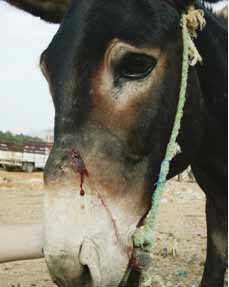
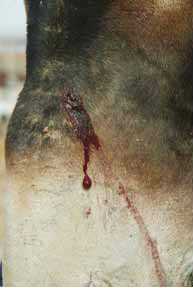
Definition: a puncture wound is a wound that has depth rather than size.
Puncture wounds in the skin and hoof etc., from sharp objects (e.g. nails, glass shards, bullets or other foreign bodies) are common and potentially very serious, although they are easily overlooked or trivialized. The size of the wound often belies the potential severity of the injury. The skin defect is usually trivial by comparison to the deeper damage. Even apparently minor wounds can be fatal if they involve synovial structures, the cranium or the body cavities. There is a high risk also from infection and anaerobes are particularly dangerous. The wounds may be difficult to explore effectively; this applies particularly to the sole of the foot. Infections of the interstitial tissues and the lymphatic vessels are termed cellulitis and lymphangitis respectively. In either case, infection can spread extensively from the site of the injury. This type of wound proves the ideal anaerobic environment for Clostridial organisms to flourish. Clostridium tetani is possibly the most dangerous of these.
Management of puncture wounds requires a detailed knowledge of the regional anatomy and some information on the cause and the direction of the penetration. Puncture wounds must be treated by scrupulous cleaning and, if necessary, widening of the injury to ensure full cleaning and avoidance of anaerobic conditions. Antibiotics and non-steroidal anti-inflammatory drugs are usually used. Controlled movement is usually considered to be an important aid to treatment. Tetanus prophylaxis is a major issue.
Healing of the skin wound is incidental in all cases.
References
- Knottenbelt, D. (2008) The principles and practice of wound mamagement In Svendsen, E.D., Duncan, J. and Hadrill, D. (2008) The Professional Handbook of the Donkey, 4th edition, Whittet Books, Chapter 9
|
|
| This article has been peer reviewed but is awaiting expert review. If you would like to help with this, please see more information about expert reviewing. |
Definition: an incised wound is one in which the skin is cut cleanly with minimal tearing and bruising of the wound margins.
An incised wound (including a surgical wound) has a sharply defined margin and is caused by sharp metal or glass, flint or occasionally the leading edge of a shoe. In accidental wounds concurrent injury to non-cutaneous structures is common.
The reflex arterial constriction that occurs when skin is cut means that there is usually remarkably little haemorrhage in the immediate post-injury stage. Thereafter, there may be considerable haemorrhage associated with vasodilation, especially if arteries/arterioles are involved. Haemorrhage may be controlled by pressure bandaging or clamping/ligation of significant vessels.
Incised wounds are often amenable to first intention healing and, with the possible exception of the distal limb where there is some controversy over the need to or benefit from suturing, healing is correspondingly rapid.
Important note As nerves and arteries often run in close proximity, blindly feeling for the vessel with a pair of haemostats in the conscious donkey can be very dangerous!
References
- Knottenbelt, D. (2008) The principles and practice of wound mamagement In Svendsen, E.D., Duncan, J. and Hadrill, D. (2008) The Professional Handbook of the Donkey, 4th edition, Whittet Books, Chapter 9
|
|
| This article has been peer reviewed but is awaiting expert review. If you would like to help with this, please see more information about expert reviewing. |
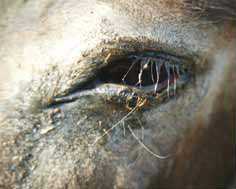
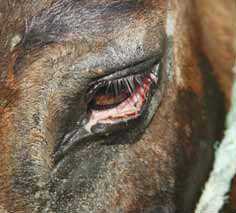
Definition: a laceration is a traumatic tearing of the skin in an uncontrolled fashion.
Lacerations are the commonest skin injuries in donkeys. Multiple tears in the skin may be accompanied by bruising but haemorrhage is rarely a problem.
Management of lacerations usually involves careful wound preparation and restoration of anatomical integrity by means of sutures or staples. Antibiotic therapy is usually applied for a period of four to six days. The absence of ‘spare’ (loose) skin on limbs means that large deficits in these sites require particular care. There is seldom any spare skin that can be mobilized and so a prolonged recovery and/or expensive surgical procedures may be expected.
Degloving injuries are commonest on the upper limb regions. The skin on the lower limb is probably more firmly attached and seldom ‘degloves’ in the same way as the upper limb and body trunk. These injuries should be promptly treated to restore as much of the skin as possible to its original position (even if it is probably non-viable). Degloving of limbs usually involves at least some horizontal skin laceration and is usually in a downward direction so that the skin hangs around the limb. The exposed subcutaneous tissues rapidly become dry and infected but remarkably little bleeding occurs in most such cases. The blood supply to the upper margin of the wound is usually intact and so this is less of a problem than the distal wound margin, which is invariably compromised, especially at the most central part of the wound margin. Sloughing of the skin along this margin is common.
The wound should be irrigated with copious warm sterile saline and protected from further contamination by application of a hydrogel to the exposed tissues. This will minimize dehydration and infection. Restoration of the flap to its normal position as far as possible maintains warmth, prevents further contamination and devitalisation and covers the exposed tissues with a biological dressing. If feasible, a bandage should be applied to limit further damage until a detailed examination can be performed. Movement of the limb should be minimized so that tension on the wound is reduced as far as possible. Shear forces will be maximal during movement of the underlying muscles relative to the skin.
The wound should be carefully examined (possibly even under general anaesthesia) and, after superficial irrigation, all obvious foreign matter and devitalised subcutaneous tissues are scrupulously removed. Deeper injuries are treated by lavage and, if indicated, by suturing the defects with an absorbable suture material of suitable diameter and pattern. Skin should not be removed unless it is totally devitalised and shredded; this applies particularly to the eyelids.
Once the deep tissues have been repaired (possibly with drain placement), the skin is restored to its normal position. Excessive tension on the wound site will almost always result in wound dehiscence and further complications. Carefully placed and securely knotted sub-cutaneous ‘walking’ sutures of a fine absorbable material may allow the wound to be closed without undue tension and will provide support for the flap of skin. However, if the injury is more than one or two hours old, the skin will have shrunk significantly and it may be difficult to restore it to its natural position. Undermining the adjacent attached skin and making small 1 cm long overlapping relieving incisions (running parallel to the wound margins) may permit the skin to be restored fully to the normal site without any undue tension on the wound margin. Alternatively, it is sometimes wise not to attempt to restore the skin fully to its position and simply suture the skin to the underlying tissues, as near as possible to the wound margin without excessive tension. The uncovered area will then heal by second intention but will of course be much smaller than the original wound and may be amenable to skin grafting in due course.
The skin wound is closed using interrupted horizontal or vertical mattress sutures with monofilament nylon (4 or 5 metric/1 or 2 USP). Tension across the wound site can also be relieved by using supported quill sutures or a stent.
Suitable dressings and bandages and antibiotic therapy are useful in all cases. Movement should be restricted depending on the extent and type of wound, and dressings should be changed as and when indicated.
Variable necrosis of at least part of the skin margin is commonly present. In any case the necrotic tissue will eventually need to be removed and the wound allowed to heal by second intention or by some form of grafting.
Uneventful healing should take place regardless of the anatomical location of the wound but can be problematic, especially on the limbs. Complications may be present such as skin loss or degloving and such wounds are best regarded as ‘complicated’. The prognosis is less favourable than for incised wounds because tissue necrosis and sloughing are frequent complications.
References
- Knottenbelt, D. (2008) The principles and practice of wound mamagement In Svendsen, E.D., Duncan, J. and Hadrill, D. (2008) The Professional Handbook of the Donkey, 4th edition, Whittet Books, Chapter 9
|
|
| This article has been peer reviewed but is awaiting expert review. If you would like to help with this, please see more information about expert reviewing. |
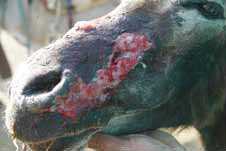
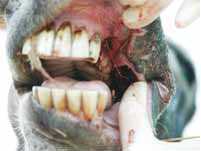
Definition: a wound that has components of one or more of the other types that is complicated by factors that either preclude simple primary union or are likely to result in serious delays in healing.
Complicated wounds are commonly seen in equine practice. The management of complicated wounds is always problematic. Some require careful anatomical reconstruction and others require various other techniques. In all cases the wound management procedure must be followed carefully.
Initially the wound must be protected from further damage until a detailed exploration can be performed. For this reason it is common practice to apply a hydrogel and a dressing while the animal is moved to a suitable facility. Involvement of other organs or structures may be more significant than the skin injury itself. One of the most critical factors is a full exploration of the wound. In some cases this can be performed with the sedated standing animal but in others a general anaesthetic is advisable. The extent of the injuries may mean that the skin wounds are insignificant (e.g. compound fractures of the limb bone, open body cavities, etc).
Healing depends on the extent of damage and ability of the structures involved to heal.
References
- Knottenbelt, D. (2008) The principles and practice of wound mamagement In Svendsen, E.D., Duncan, J. and Hadrill, D. (2008) The Professional Handbook of the Donkey, 4th edition, Whittet Books, Chapter 9
|
|
| This article has been peer reviewed but is awaiting expert review. If you would like to help with this, please see more information about expert reviewing. |
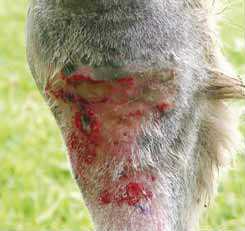
Definition: a burn is an injury that results from the application of harmful abnormally high (or low) temperatures.
Fortunately burns are rare in donkeys but there are several different types, and each has its own complications:
- Thermal burns
- Scalding
- Friction burns (rope galls or grass grazes)
- Chemical/caustic and exudate ‘burns’
- Freeze ‘burns’
- Actinic sunburn
The face, eyes, breast, back and legs are most often involved as a result of stable or grass fires. While flash burns from explosions usually affect the head, breast and neck, barn or stable fires often result in smoke inhalation that can be at least as serious for the donkey as the most extensive burns.
Burns are described by extent (percentage of body surface) and depth of tissue damage (first, second and third degree).
Rope or focal burns from other causes are simply minor forms of skin necrosis resulting from friction rather than flames. The true extent of the damage may not be apparent immediately and so management must be directed at general supportive measures and focused wound management. Small burns benefit from being covered with a hydrogel immediately and then left to slough. There is no advantage in bursting blisters. Extensive fresh burns should be cooled with cold running water as fast as possible – this is known to limit the severity to some extent. Thereafter hydrogel application and possibly antibacterial creams are advised because burns appear to have an increased tendency to infection.
References
- Knottenbelt, D. (2008) The principles and practice of wound mamagement In Svendsen, E.D., Duncan, J. and Hadrill, D. (2008) The Professional Handbook of the Donkey, 4th edition, Whittet Books, Chapter 9
|
|
References
- Knottenbelt, D. (2008) The principles and practice of wound mamagement In Svendsen, E.D., Duncan, J. and Hadrill, D. (2008) The Professional Handbook of the Donkey, 4th edition, Whittet Books, Chapter 9
|
|